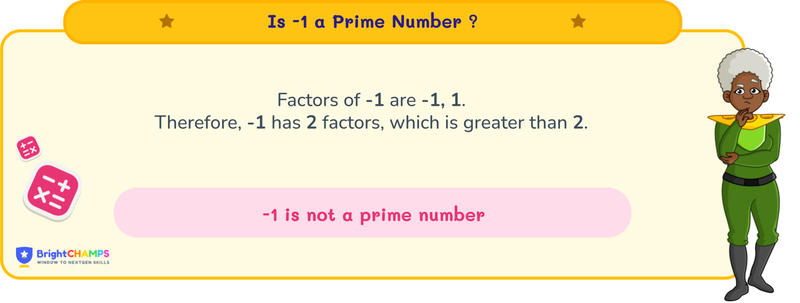Summarize this article:
 248 Learners
248 LearnersLast updated on August 5, 2025
Is -1 a Prime Number?

Prime numbers are numbers that have only two factors: 1 and the number itself. They are used in various fields such as encryption, computer algorithms, and barcode generation. In this topic, we will discuss whether -1 is a prime number or not.

Is -1 a Prime Number?
Numbers can generally be categorized as prime numbers or composite numbers based on their factors.
A prime number is a natural number greater than 1 that is divisible only by 1 and itself.
For example, 3 is a prime number because its only divisors are 1 and 3.
A composite number has more than two divisors.
For example, 6 is a composite number because it is divisible by 1, 2, 3, and 6.
Prime numbers have the following properties:
- Prime numbers are positive and greater than 1.
- 2 is the only even prime number.
- They have only two factors: 1 and the number itself.
- Any two distinct prime numbers are co-prime numbers because they share only one common factor: 1.
Since -1 is not a positive number, it cannot be a prime number.

Why is -1 Not a Prime Number?
The defining characteristic of a prime number is that it has exactly two positive divisors: 1 and itself. Since -1 is a negative number, it does not meet this criterion and thus cannot be considered a prime number. Here are a few methods to identify prime numbers:
- Counting Divisors Method
- Divisibility Test
- Prime Number Chart
- Prime Factorization

Using the Counting Divisors Method
The counting divisors method involves counting the number of positive divisors of a number to determine if it is prime. A number is prime if it has exactly two positive divisors.
If a number has exactly 2 divisors, it is prime.
If it has more than 2 divisors, it is composite.
Since -1 is negative, it does not have positive divisors and therefore cannot be prime.
Explore Our Programs



Using the Divisibility Test Method
The divisibility test involves checking if a number is divisible by any other positive number besides 1 and itself.
This method helps determine if a number is composite.
For -1:
Divisibility by any number does not apply because -1 is negative.
Prime numbers need to be positive integers greater than 1.
Thus, -1 cannot be a prime number.

Using Prime Number Chart
A prime number chart is often created using the "Sieve of Eratosthenes."
This method involves marking numbers as prime or composite by eliminating multiples of each prime starting from 2.
By this method, we identify prime numbers between 1 and 100 as 2, 3, 5, 7, 11, 13, 17, 19, 23, 29, 31, 37, 41, 43, 47, 53, 59, 61, 67, 71, 73, 79, 83, 89, and 97.
Since -1 is not a positive number, it does not appear in the prime number chart and thus is not a prime number.

Using the Prime Factorization Method
Prime factorization involves expressing a number as a product of prime numbers.
However, prime factorization applies only to positive integers greater than 1.
Since -1 is negative, it cannot be factored into primes, and thus prime factorization does not apply.

Common Mistakes to Avoid When Determining if -1 is Not a Prime Number
Learners may have misconceptions when learning about prime numbers. Below are some common mistakes and corrections.

FAQ on Is -1 a Prime Number?
1.Is -1 a prime number?
2.What are the divisors of -1?
3.Can negative numbers be prime?
4.Why can't -1 be in a prime number chart?
5.What are the closest prime numbers to 0?

Important Glossaries for "Is -1 a Prime Number"
- Prime numbers: Positive integers greater than 1 with exactly two distinct positive divisors: 1 and the number itself. Example: 5 is prime because its divisors are 1 and 5.
- Composite numbers: Numbers greater than 1 with more than two positive divisors. Example: 4 is composite because it has divisors 1, 2, and 4.
- Divisors: Numbers that divide another number exactly without leaving a remainder. Example: 3 is a divisor of 9 because 9 ÷ 3 = 3.
- Negative numbers: Numbers less than zero. They do not qualify as prime numbers.
- Sieve of Eratosthenes: An ancient algorithm for finding all prime numbers up to a certain limit by iteratively marking the multiples of each prime number starting from 2.



Hiralee Lalitkumar Makwana
About the Author
Hiralee Lalitkumar Makwana has almost two years of teaching experience. She is a number ninja as she loves numbers. Her interest in numbers can be seen in the way she cracks math puzzles and hidden patterns.
Fun Fact
: She loves to read number jokes and games.

















